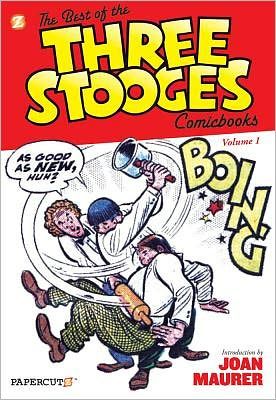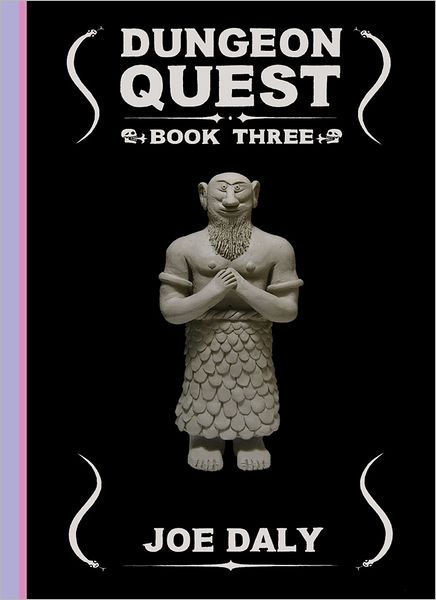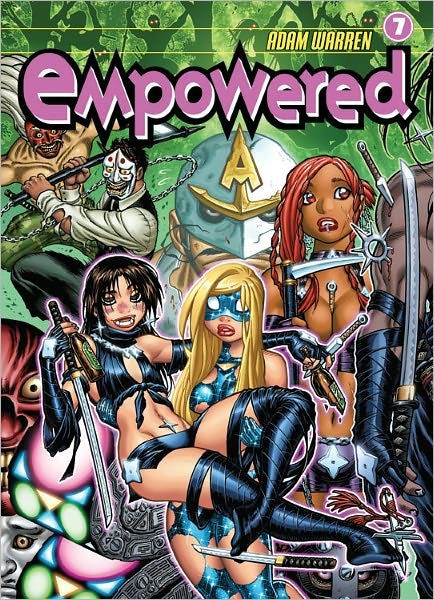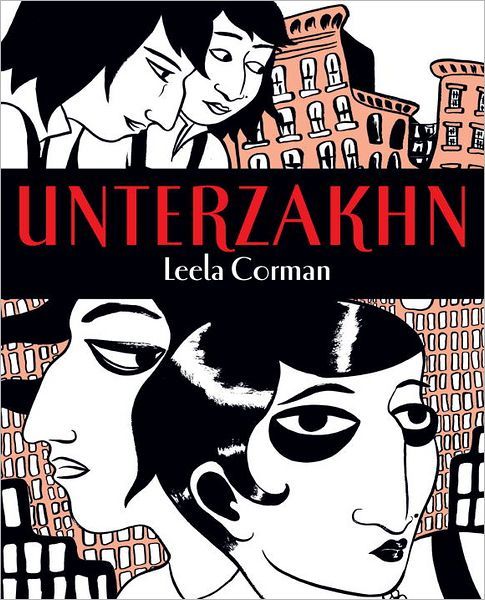The Best of the Three Stooges Comicbooks, Vol. 1 (Papercutz) Well, here’s at least one good thing to come out of the Farrelly Brothers’ new feature film: Its production company C3 Entertainment teamed with Papercutz/NBM to produce this handsome hardcover, which collects chunks of Stooges comics from two different eras.
The best of these are from defunct publisher St. John’s early-1950s Three Stooges comic (issues 1, 4 and 5, to be precise), and were drawn by Norman Mauer, a gifted comics artist who married the real Moe’s daughter, Joan (who provides the introduction to the volume).
Mauer edited the original book (along with partner Joe Kubert), and delivered action- and gag-packed pages featuring Moe, Larry and Shemp. His designs of the central characters are incredibly strong, with Shemp and Moe much more distinctly defined than they often were in their black-and-white short films.
The pair of them are short, roundish figures who favor clown-like garb, including baggy pants and ill-fitting coats and ties. Mauer’s Larry is more elongated in appearance, and, unlike the others, has a more placid, emotionless look in his eyes.
There’s a fourth character, swindler and conman Benedict Bogus, who constantly tries to put one over on our heroes, but his schemes always end up hurting him more than them. These stories can prove rather wild and formless, as if Mauer were plotting them while drawing them, and resolving them only when he was running out of pages left to fill, but the cartooning is super-sharp, and many of the panels are a joy simply to look at.
The back half of the collection includes the first three issues of the Dell comics, by Pete Alvarado, whose artwork has a coloring-book simplicity to it, as he was aping the style of the Three Stooges cartoons of the time. For these stories, Shemp is out and Curly’s in.
The art is flatter and simpler, as is the storytelling and the gags, although Alvarado took advantage of the liberty of doing comic book stories with comic book characters based on actors rather than real actors to tell some rather unlikely Three Stooges stories, sending them to meet aliens on Mars.
Both sets of comics stories are rather notable for their relative lack of slapstick violence, the thing the Stooges remain best known for. They hit one another occasionally, but not with the frequency and intensity of their real, live models, which is perhaps only noteworthy because one might expect the comic book characters to behave more like cartoon characters than the real Stooges did, but that was not the case, which is perhaps a testament to how good the real Stooges were at what they did.
If nothing else, this book draws attention to the work of Mauer, and he’s a talent deserving of any and all attention paid him.
Dungeon Quest Book Three (Fantagraphics Books) There are plenty of amazing things about Joe Daly’s impeccably drawn stoner-fantasy RPG comedy. High on that list is that this is the third volume clocking in at several hundred pages, and there’s a “Dungeon Quest Logbook” showing our heroes’ progress on their seven quests, and, by book’s end, they’ve only completed one of those quests.
Does that mean Daly’s got another 18 books of this thing to go?
That probably wouldn’t be a bad thing, mind you.
Beyond the quality of the artwork, which remains amazingly detailed and perfectly perfect in its storytelling, Dungeon Quest is really funny, the humor sometimes seeming dissonant—but pleasingly so—given the seriousness with which Daly approaches, say, drawing a rock-strewn valley or depicting a slow, tiring march through a forest (Daly's almost Tolkeinesque in his commitment to describing walking!) or choreographing a thrilling action scene.
In this volume, our heroes learn the secret history of Atlantis and all world religion, smoke some super-powerful Orangutan Daydream weed. Millennium Boy finds a lost book of lore and, as he reads it while still tripping balls, the comic becomes the prose book he’s reading for about 25 pages. Then they fight some horrible monsters and are attacked and stripped of all their possessions (clothes included) by a band of bandits.
The proceedings are pretty penis-focused, as one character has a vision in which he loses his penis but gains a second, extra penis; the character named Lash Penis battles a monster by repeatedly tugging on and punching its penis; the boys spend a major part of the climax nude, and thus with their "willies," as Lash calls them, out, and, finally, they encounter a pretty perverted little forest man who aids them in exchange for a handjob.
This is exactly what the fantasy genre needs more of: dick jokes.
Empowered, Vol. 7 (Dark Horse) The most immediate virtues of Adam Warren’s series remains his personalized, Westernized manga-style artwork in what is essentially a direct-to-tankobon manga series, his unique ability to present exploitative imagery in service of a story featuring one of the most well-rounded and realistic women in superhero comics (the “having his cheesecake and eating it to” aspect of his Empowered), and the fun, witty, expletive-filled dialogue in which almost everyone talks the same, but it hardly matters because they all talk in an almost-exhaustingly quick-paced, joke-filled slang .
These virtues are so immediate, so omnipresent, and so distinct in comparison to what’s going on in just about every other American comic book to feature superheroes and supervillains that’s easy to forget just how good Warren is at everything in this book.
For example, how well-orchestrated and thrilling his action sequences are, and since the majority of this book involves supporting character Ninjette’s battle with a powerful group of ninja warriors that greatly outnumber her, there is a whole lot of amazingly choreographed and executed action scenes.
Or, for another example, how good Warren is at more tender, emotional scenes, as in the one where The Caged Demonwolf, the cosmic being trapped in a power belt on Emp and company’s coffee table, drops his pretense of talking like Stan Lee re-writing H.P. Lovecraft to share his true feelings for Ninjette.
The content and the peculiarities of Warren’s storytelling might mean Empowered isn’t for everyone, but, if it’s for you, then you already know what this latest volume once more demonstrates—Empowered is the best superhero comic anyone’s doing anywhere.
Star Wars: Darth Vader and Son (Chronicle Books) The cartoons in this original collection by Jeffrey Brown all operate on a very simple premise, one evident in its cover image and title: What if, rather than meeting one another in the unfortunate circumstances that they did in the movies, Darth Vader was a single dad raising 4-year-old Luke Skywalker himself?
The 60 or so pieces, most of them one-panel cartoons, although there are a handful of multi-panel strips, tend to find their humor in one of two places. Sometimes there are rather straightforward riffs on Star Wars events and lore, in which Vader will re-use dialogue in different situations, for example, or when other characters will appear.
In many instances, the gags will have nothing to do with Star Wars beyond the involvement of Vader and little Luke, as in one where Luke falls asleep on his dad’s arm while the pair nap, the humor simply coming from the disconnect between the completely common with these singular fantasy characters, at least one of whom we’re used to seeing as a horrible villain, rather than a loving father.
The ones I liked the best are those that explored the tension between the characters’ movie alliances, as in ones in which Luke asks his father if Darth Maul is a good guy or a bad guy, or why it’s called a “Death Star,” and Vader must awkwardly try to protect his young son from the truth. I like those one, and others which show a tension between the two different trilogies, with the child gravitating toward the second one (“This isn’t the toy you’re looking for …” Vader tries to Force-dupe Luke when the latter picks out a Jar-Jar Binks toy).
The fact that these are all from Brown, one of comics’ most notorious heart-on-his-sleeve artists, makes the mixture of occasionally saccharine sentiment and loving nostalgia hard to resist. “Heart-warming” and “darling” aren’t really the sorts of adjectives one might associate with a Star Wars comics project, but there you have it.
It’s hard to imagine this working so effectively in the hands of another talent, just as many of these jokes and observations likely would prove effective if they were rendered in something other than Brown’s highly-personal, almost amateur-looking homemade style art. This is particularly sharp and refined art from Brown — and in color, too! — but it’s not the least bit slick, making this a rather extraordinary comic that manages to be filled with characters and gags based on a corporate entertainment franchise while remaining deeply personal in look and feel.
The Three Stooges #1: Bed-Bugged and Other Stories (Papercutz) Nyaaaa! In an attempt to cash in on/further the entertainment experience of the new feature film, NBM’s Papercutz imprint has put together an all-original comic book, in the digest-sized trade format similar to its winning Smurfs reprints.
The stories are set in the “continuity” of the new movie, but that amounts to little more than references to the nuns at the orphanage the Stooges apparently grew up in and at least one nod to a reality show they appeared in. Additionally, photos of the actors who portrayed them in the film appear in the opening pages and on the back cover.
The book is divided into a series of short stories in which the Stooges attempt to get various jobs—sumo wrestlers, actors, exterminators — with shorter, one-page gag strips breaking them up. They’re mostly by a pair of old hands, both of whom worked extensively for Archie Comics in the past: writer George Gladir and artist Stan Goldberg.
The quality of the work, sadly, doesn’t reflect their decades of experience. The comics all seem hacked-out, with rough, occasionally sketchy-looking artwork that is unable to settle on strong, consistent character designs. These Stooges don’t really resemble the film Stooges, or the old cartoon and comic book Stooges, or the original film Stooges, but rather three generic designs distinguishable only by their hair color.
The intended audience is obviously quite young, so I don’t want to be too hard on the book, but it’s of an exceedingly, disappointingly low quality, and looks and reads even worse if read in conjunction with the previously discussed The Best of the Three Stooges Comicbooks, Vol. 1, from the same publisher. In the interests of not saying anything if you don’t have anything nice to say, I will note that, like the Smurfs volumes, this is a pretty great deal in terms of comics pages to dollars spent: $7 for 54 pages of comics, with a spine and no ads save some house ads at the back.
Unterzakhn (Schocken Books) Leela Corman’s original graphic novel, titled after the Yiddish word for “undergarments,” is set in turn-of-the-20th century New York City and stars Esther and Fanya, the daughters of immigrants to the teeming, still-emerging city.
Despite their shared nature, their nurture begins to deviate when they're 6 years old. The neighborhood “lady doctor” takes an interest in Fanya, teaching her to read and, shortly after, to start working for and then with her in her practice. Esther, meanwhile, is entranced by the local theater, and takes a job working for the madam that runs the burlesque/bordello…work that becomes more traditional when she’s raped by one of the clientele.
Their paths diverge sharply and occasionally, reluctantly intersect as they grow into adulthood in what ends up being a fairly gripping drama-turned-melodrama about the plight of women in the first years of the last century and the bittersweet, heart-breaking nature of growing up and growing apart in any century.
Though black and white, Corman’s comic is filled with colorful characters, each lovingly, dramatically rendered in a loose, abstracted style of exaggerated design, one that belies the complexity of the fully-realized sets and setting they move through. These include not only the sisters, their mother, their father—as both a young, adventurous man in the old world and a tired, cuckolded man in the new world—and the women shaped them and the men that flit in and out of their lives, but even the minor players, even the people crowding the backgrounds of street scenes.
Viewed as either a story or as art, it’s an exceptional piece of work. Viewed as story as art, it’s a tour-de-force.







